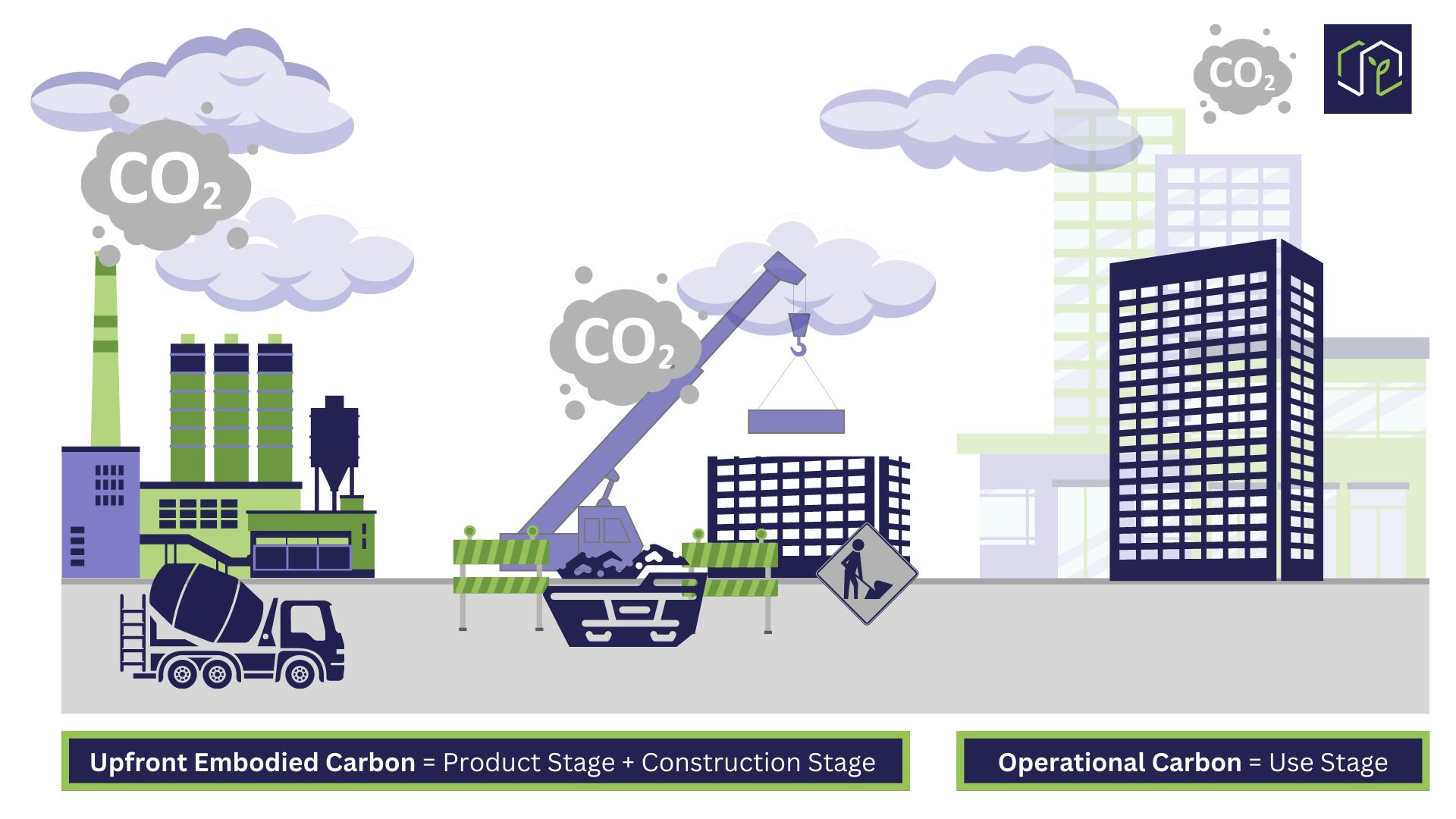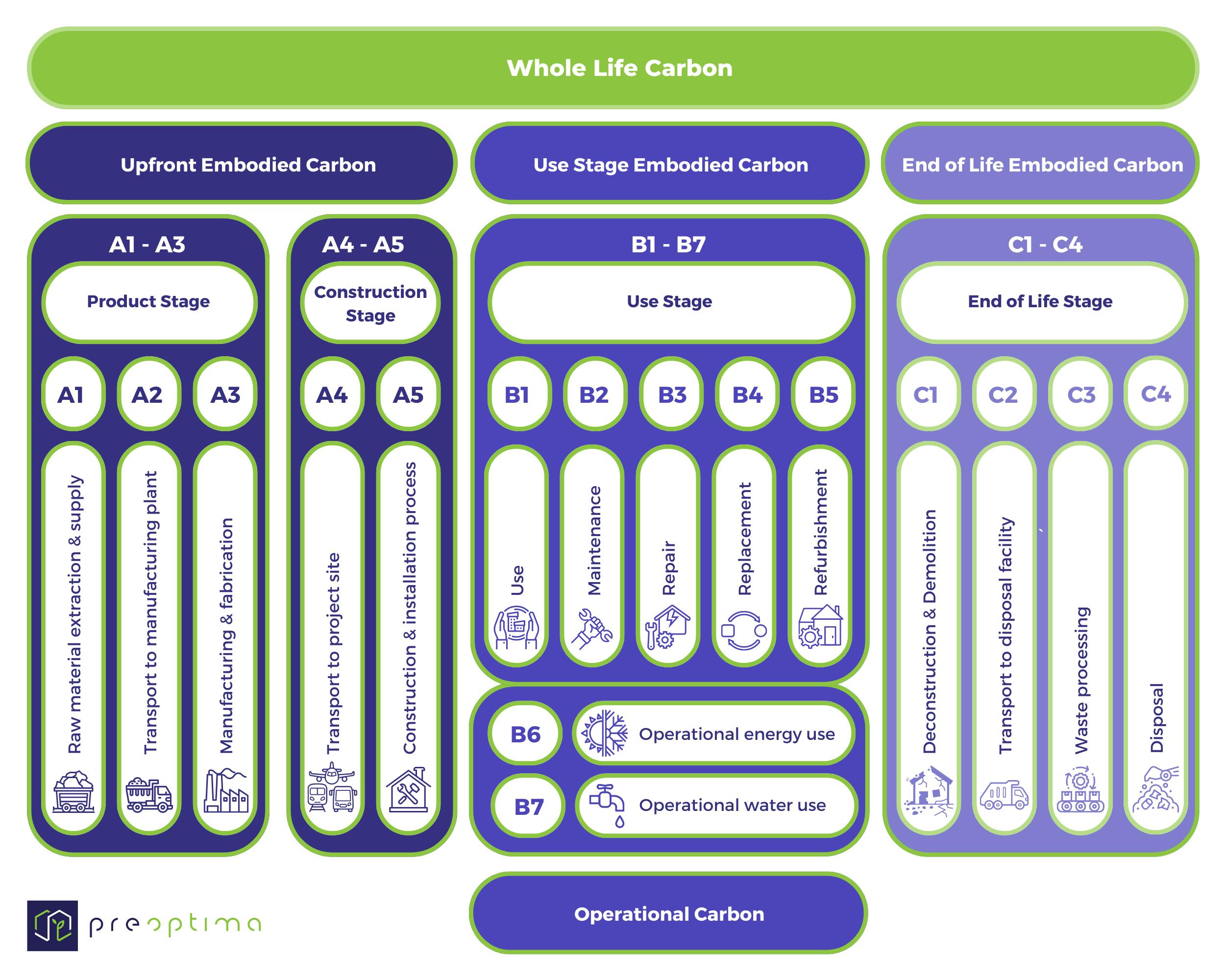Covering Embodied Carbon Series
Covering Embodied Carbon: what is it?
Read Time 4 mins | Written by: Alex Bantock
TL;DR
- The built environment accounts for nearly 50% of global emissions and 39% of energy-related emissions.
- Embodied carbon accounts for the emissions from raw material supply, material transport, manufacturing, transport to the job site, and the construction and installation processes
- A Whole Life Carbon perspective provides a more holistic view of a building's impacts and allows us to identify critical ‘hotspots’ for reducing its carbon impact
News articles, business transitions, climate activists, political agendas and the like have made us all aware that we live in a resource- and carbon-constrained world. Human activities since the industrial revolution have resulted in the accumulation of potent greenhouse gases (GHGs), primarily carbon dioxide, which absorb infrared radiation in the Earth’s atmosphere and thus trap heat. This ‘greenhouse gas effect’ is causing global warming, in turn triggering climate change, and is therefore something that requires immediate attention and global action.
The role of the built environment
The built environment in particular accounts for nearly 50% of global emissions and 39% of energy-related emissions. Whilst operational carbon (the carbon emissions arising from the use stage of a building) has come under the spotlight in sustainable buildings; the less discernible embodied carbon (carbon emissions from raw material supply, material transport, manufacturing, transport to the job site, and the construction and installation processes) has only just come under the industry’s focus.
Embodied carbon gets its name because it can be said that all of the emissions from the product and construction phase of the building are ‘locked in’ or become a part of the building - we cannot change/reduce these emissions once they have been released. The Paris Agreement warns that to avoid catastrophic and irreversible damage, we need to “limit global warming to well below 2, preferably to 1.5 degrees Celsius, compared to pre-industrial levels” by 2050. Therefore, with the accumulation of GHG emissions in the atmosphere and the short time in which to limit/reduce them, it can be said that the emissions released now (e.g. embodied emissions from new construction) are more crucial to reduce than emissions released later (e.g. operational emissions during building use).

The building lifecycle
It must be noted that the concepts embodied and operational carbon do not make up the entire picture. As discussed, carbon emissions from buildings are temporal (i.e. the extent and manner in which emissions are released depends on the stage of the building lifecycle), thus making it important to look at buildings from a whole life carbon (WLC) perspective. The building lifecycle is made up of four stages, all of which have carbon implications: Product [A1-A3], Construction [A4-A5], Use [B1-B7], and End-of-Life [C1-C4]. If one thinks critically about these lifecycle stages, they can see that some embodied carbon will still be incurred during the use and end-of-life stages, for example from building refurbishments or demolition. Therefore, whilst the emissions from the product and construction stages is broadly referred to as embodied carbon, it is more appropriate to refer to it as ‘upfront’ embodied carbon (the embodied carbon of the building prior to occupancy).
Now, we understand that the numerous carbon-related terminologies and definitions can get a little confusing and agree that the built environment needs to achieve consistency when it comes to these basic definitions. To help you out, check out the Improving Consistency in Whole Life Carbon Assessment and Reporting document by the Whole Life Carbon Network (WLCN) and LETI, which provides all of the carbon definitions you need to know.
Viewing carbon using a lifecycle approach gives us a more holistic view of the impact of a building and allows us to identify critical ‘hotspots’ for reducing its carbon impact. Instead of just focussing on operational carbon (as we currently are) or drastically changing gear to target upfront embodied carbon (as we most likely will), it is important to adopt a WLC thinking approach and realise that buildings will have a big impact now and continue to do so across their entire building lifecycle.
One example to present and strengthen the case for embodied carbon is to actually think of a real scenario. Assume, for instance, you want to upgrade your old windows with new ones which perform better - that is, they’ll reduce your energy bills. Most people would think of it as an investment/return problem: if I spend X to buy the new windows and save Y on energy every year by having them, when will Y outweigh X? We often term this as payback period - and the shorter it is, the more convinced we are about the installation of our new windows. A similar mindset is required for embodied and operational carbon, because one influences the other. So in the same case of our windows, we shouldn’t only be looking at the reduced energy bills (and subsequent reduced operational carbon) we’ll get as a result of the upgrade but also the embodied environmental costs that the new windows will incur. The only difference is that it isn’t a bank lending us the resources, but our planet. It’s essentially a loan against the future, so we’d better make sure its payback period is damn short!

We'd love to hear from you!

